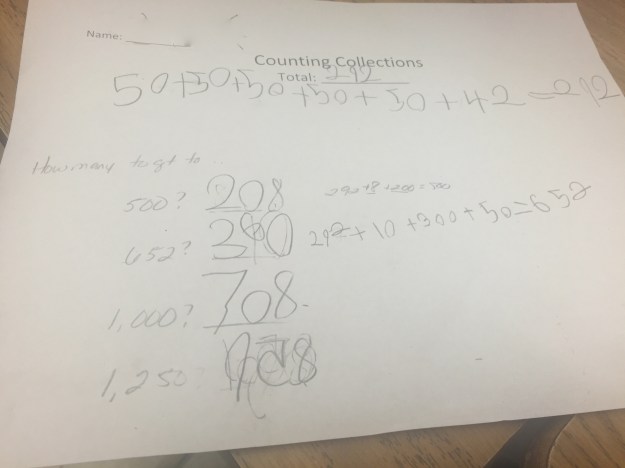Today in 1st grade, we did a counting collections activity. One thing I am thinking about as I see this activity happening in K-2 classrooms, is the extension. While choosing questions for students who are struggling is difficult, choosing questions for those who are finished quickly, and correctly, I find just as difficult. What questions can we ask those students who organize, count and can explain their count perfectly?
I have been toying around with this idea for a bit. I have thought about asking them to combine collections, ask how many more they would need to get to another number or mentally adding tens and hundreds to their count.
Today, I tried asking a student how many more to get to another number. It was pretty cool and led to some more ideas. He and his partner ended with 292. I asked how many more to get to 300? 8. 350? 58. He could explain using the 8 to get to 300 and how to move forward from there. Because of other groups I wanted to chat with, I left him with 500, 652, 1,000, and 1,250. He came back with the answers, but no explanation and said, “I don’t feel like writing all of that out.” I asked him to explain how he got to 500 and I would record the equation for it. He said he added 8 to get to 300 and then 200 more to get to 500, so 208. He was shocked to see it as an equation because he thought I meant to explain it all out in words. I asked him to try the next one and he started with adding 10. He said he wanted to keep the 2 ones to make it easier, awesome. When he said that, I had another idea to have students think about what place values are changing as they add to a certain number. I want to ask him why he ended with 8 ones on three of them but zero ones in another?

I know I have seen tons of people on Twitter using counting collections and would love to hear of other ways we could extend this activity in the comments!
Hi — we’ve tried similar extension — how far away is your collection from ….
Other extensions:
1. try counting your collection in a different way
2. how could you arrange your groups to make the counting easier (this gives students to explore structuring their groups in arrays).
3. can you sort your collection and think about the raw data that you could produce: 76 red beads, 25 orange, 14 blue. What kinds of problems could you create ((but this extension goes far afield from counting collections))
4. get a new collection — try new ways of counting your collection.
5. comparing collections — how many more in yours than in your pairs.
6. what are different ways of notating how you counted your collection (diagram, expressions)
LikeLike
I love seeing how kids as young as first grade can handle multi-digit computation! We have multi-age classrooms and do a lot of counting collections. I find that kids who are good at counting and organizing collections like the one you described above do very well with counting more challenging collections. I like to have them count the legs on the tables and chairs in the room, or the books in the classroom or all of the writing utensils. They can’t move and touch each of these items because some of them are being used and some of them would require a great deal of work to move and organize. This leads kids to having to count parts of collections and then put them together which leads to some great addition problems and compare problems.
I have been thinking about counting backwards and how to include this in counting collections as well and would love some ideas!
LikeLike